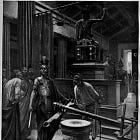Defeating the Discombobulating Dialectic: Or, Just Trade the Damn Thing! Part I.
Catching a glimpse of the market's most interesting behaviours.
At the AXIA trading desks.
Tuesday 19th November 2024,
Limassol, Cyprus.
“But yeah, it was weird!”
“It felt like the markets wanted to go that way beforehand,” so continued this trader. “But these headlines were little triggers. Then everyone decided that these headlines must be moving it, and they all just jumped in! From experience, you usually look past these comments and think nothing of them. But you have to adapt…”
This highlights one of the market’s most intriguing features: its ability to observe and adapt to itself, altering the very question we’re trying to answer simply by attempting to answer it.
Here’s the chicken-and-egg problem: Would the market movements on Tuesday morning—the Bund’s rally, for instance—have occurred if the headline ‘Putin Approved Updated Nuclear Doctrine’ had emerged under different market structure and participant positioning?
Suppose the market’s positioning favoured the downside in Bund futures. In that case, how would the risk-off bid on a nuclear doctrine headline have affected the market? The headline comes out; the reaction is muted. Newswires, journalists, and the news flow don't care—no rehashing. We move on, just as the markets did with the first update to Russia’s nuclear doctrine in September and countless other headlines over the years. No one would label such a day as ‘headline-driven,’ least of all the newswires.
But this time, it just so happens that the Bund’s structure and participants are positioned in such a way that probabilities favour the upside. And a ‘risk-off’—danger!danger!—headline comes up and causes momentum calamity.
Reaction! News flow causing order flow. Or is it order flow causing news flow? The narrative shifts and warps. Markets are sensitive again to the Russia-Ukraine War! Or are they, really? And then the other markets react. It must be! Oh, wait—the show is over. Come Back For The End Of The World Next Tuesday. Hence, we caught a glimpse of a wily old shadow: the market’s self-fulfilling prophecy.
But these traders executed it all the same.
Spoiler first: the day went to the traders with an explicit framework—ostensibly called ‘technical trading.’ Or rather, the successful technical traders are those with an explicit framework—one that filters and shapes their understanding of market activity. And in AXIA’s case, this is strongly tied to the Market Profile and ‘market auction theory.’
In other words, their strategic thinking led them to focus on the right markets, holding back heavy leverage until the perfect moment—the ol’ Schwerpunkt. Ultimately, this is what any long-volatility, outright futures trader must do: identify moments of low variance and strike decisively. To smartly seek asymmetric opportunities and, once confident, aggressively increase position size—that’s the mark of a true Asymmetrist.
And this time round, the ‘technical traders’—an abused label, but let’s go with it—had the edge. AXIA’s premier market profile asymmetrist swiped multi-six figures from the Bund alone. Other senior traders, developing these same skills, also put up strong performances. Definable outperformance on a relative basis, firm-wide.
Putin Approved Updated Nuclear Doctrine — TASS.
“Bollocks headline like usual,” said he—our golden haired, good old lad from Notts, a young buck; an AXIA home-brew special! Who grew up as a runner on the London floor and now cruises in his ever present white trainers in the Limassol office. Young, yet not junior—now armed with enough firepower and consistency to put up $20,000–40,000 days when the order flow sings.
And he will be our guide throughout this Dispatches issue, because he is just as comfortable with the Profile, the market structure—the technical trading—as he is with macroeconomic, news and event trading. His leans more into the latter—but he sees both sides! And the professional of the future sees no distinction.
This acknowledges that markets are too complex to be crudely divided into ‘fundamentals’ or ‘technicals.’ As another trader noted this week: it's limiting to think of each market move as simply ‘bullish’ or ‘bearish.’ Don't let yourself get lost in social media's endless technical-versus-fundamental debates—that discombobulating dialectic death-loop. Let dogma die, or it will strangle your career growth. Be reductive at your peril…
But, now our good old lad explains:
What happened before and after the first Nuclear Doctrine comment?
“Admittedly, I didn’t think much in the way of opportunities this week. In fact, I was busying myself with some documents to keep myself from trading, as I always do badly when it’s quiet. Which is not a good habit.
But then we had the nuclear doctrine headline. Honestly!–I looked at the headline and the markets had not moved. Yet then every couple of minutes there was this grind going on. The Bunds wanted to go up anyway. And the bonds looked like they wanted to break up, and they had levels to take out. But it didn’t look like a typical breakout.
Then the moves got more traction. You can just see how everyone’s gone: ‘hang on! What’s going on?’ Although if you ask around, no one is sure—Crude Oil is not reacting. I didn’t think much of it at the time. Over the weekend, we had a New York Times piece about the [ATACMS] missiles. [“Biden Allows Ukraine to Strike Russia With Long-Range U.S. Missiles”], so I was there for the Sunday market open. But—nothing!”
What’s next? Sod’s law—am I right?
“Not even a joke. I went to the kitchen to fill up my water; I just hear something around the corner, so I ran back in. The traders yell out headlines—Ukraine had used American ATACMS missiles for the first time. I remembered the order flow from 2022 war outbreak, so I lifted Crude Oil and Gold futures. [The metal] was getting hammered in the last few days, so it should go. [Bid easier] But you couldn’t have picked two worse markets! You watched instead the Bund fly, and the DAX was coming off. Well—this is good!
I was getting hosed in the Oil. But Gold was not moving, so I kept the long as I knew it had to go—buying a bit more and more. Then DAX gave some short-term structure and sold a bit there.
Then the Bund offered back down, and everything started to come back. Gold started to do another leg, so I held it while I cut my Oil position. By that time, it was done!
I can sense why the ‘technical’ traders did better. Maybe they were long in the Bonds and the headlines pushed them onside. The way the structure looked, I wouldn’t be surprised that they were buying it. Or even for a fade back down. From a ‘technical’ perspective, it's one of the trades I'm working on now: when something over-extends in one line, you tend to get a pullback to fill in the path it took.”
What about the afternoon? F.M. Lavrov’s downplay comment?
“Even in the afternoon, the flows started coming in again before the comment. But the Bonds were not going bid, the Bund had come back. Yet, the DAX was getting smashed heavy—S&P too. It had gone so far so quick, you knew a bounce was coming. So I got long some S&P down there. Then we had Lavrov’s downplay comment. [Russia’s Position Is That Nuclear War Won’t Happen] Yet if you traded early Russia-Ukraine, you wouldn’t have thought anything of it. Then another headline that the U.S. won’t change its nuclear doctrine. Then the equities bounced, and bonds offered on this, creating a second leg. I was already long small size in the S&P anyway, and I added to it.”
*
So, readers, would the day have played out the same with or without the comments? Would the market have simply done what it always does—auction up and down, poke and prod and explore—while the comments were mere window-dressing? Yet, they did come out, and the tail must be pinned on the donkey—newswires rehash as the markets seem to react. Then more flow comes in, chasing the news! Thesis, antithesis, synthesis… but you know: just trade the damn thing!
This wasn’t a personal best P&L day today, but you still put up a good $20,000. How did this happen?
“I did okay in the end because I missed the first nuclear doctrine morning. It really pissed me off—it hurts me when I miss something. Why did I miss it? And when I started to miss the second one because of being in the wrong markets, I had to adapt. Which ones were actually moving? Then I got into the DAX as that was the cleanest market. Because I refused to miss it—so I really went for it. My failure on the first, really forced me to push on the second.
But I’ll explain this deeper. Normally, I would hit the Bund on risk-on and risk-off—I'd put on a decent clip. Then S&P or DAX. Yet, this time I didn't. I assumed everyone else did so well compared to me. What am I doing? Why am I here? I should quit! I’m stupid!
The P&L is just… fine. But I’m now at a place in my career trying to push and push for bigger days, and this was an opportunity to do it. So regardless of P&L, it still hurts me that I didn't take as much out as I could. My first $1000 day was amazing! Then $10,000—I couldn’t be happier. But, you know, when you really try to push—you always feel like you underperform.”
And like everyone endeavouring to manically push performance, our young buck eerily mirrors the words of the Cypriot. There is a cost to performance, and this is one of the least insidious to pay. Perform like the stuff of dreams, and it always feels pyrrhic, deflating. Should have been better. But perform badly, take a hit or a loss, and that minor wound strings terribly. This is the end! I’m finished! But as it always is: come back for the end of your career next Tuesday…
Read Part II!
Acknowledgements, Permissions & Disclaimer
Grateful acknowledgment to AXIA for granting access to one of their traders.
Photo by 愚木混株 cdd20 / Unsplash
Disclaimer: Do Not Do Stupid Financial Decisions. This Is Not A Game.




